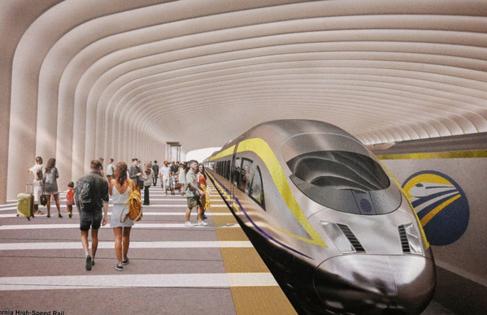California high-speed rail officials say feds' audit is 'outright misleading'
Published in News & Features
FRESNO, Calif. — Officials at the California High-Speed Rail Authority defended the project from a scathing federal audit they say is “an inaccurate, often outright misleading, presentation of the evidence.”
The Federal Railroad Administration’s 310-page report report, released last week, laid the groundwork for the Trump administration to pull $4 billion from the state’s bullet train project in the coming weeks.
In a formal response to the audit, Ian Choudri, the rail authority’s CEO, disputed the idea that the project has made minimal progress on construction. He cited high-speed rail accomplishments in Fresno as evidence of its progress in the Central Valley.
The money the Trump administration wants to pull back — a combination of $929 million awarded in 2010 and $3 billion awarded in 2023 — is earmarked for the construction of a downtown Fresno station, and extensions from Shafter to Bakersfield and Madera to Merced.
But the federal administration concluded the Trump administration should rescind the money because California’s rail authority has broken the terms of the grants in question. The state rail authority was given the opportunity to respond before a decision is made.
“Termination of the agreements is unwarranted and unjustified,” Choudri said in a Wednesday letter to the federal administration, which disputes the federal probe’s key findings about the California project.
Choudri added that the federal government has distorted data, used disingenuous methods and cited reports that don’t support its conclusions during its quest to pull the California project’s funding.
California’s high-speed rail project was initially envisioned as a Los Angeles-to-San Francisco line that would cost up to $33 billion and be operational by 2020. But the project has been plagued by delays and cost increases in the 17 years since California voters first approved a bond for its construction. The latest estimates indicate completing the project as originally envisioned could top $100 billion.
The project’s main focus is now the completion of a 172-mile Bakersfield-to-Merced railway by 2033, and fully-funded construction is underway on 119 miles between Shafter and Madera. But the rail authority is facing a reported $10 billion shortfall — previously thought to be $7 billion — as it tries to complete the Central Valley stretch.
Gov. Gavin Newsom has proposed the project receive an annual commitment of $1 billion in state money, which has covered more than 70% of its total spending thus far. The authority has also begun pitching rail connections to Gilroy and Palmdale. Both of those developments, Choudri has said, are essential to attracting private dollars.
But without federal money, more delays are possible.
High-Speed Rail Authority disputes federal audit findings
The federal government’s report includes nine key findings it says justifies divestment from California’s high-speed rail project.
The report says California has “no viable path” to completing the Bakersfield-to-Merced high-speed rail segment by 2033.
“This statement lacks any supporting facts, despite the 80,000 pages of documents (the authority) provided,” Choudri said.
Choudri said the federal report “fails to recognize” that the authority’s 2024 business plan lays out a construction schedule that allows Central Valley completion by 2033. The authority, he said, also intends to release another report this summer that details how it intends to reduce costs and tighten its construction schedule.
The federal report also cites numerous costly change orders — $1.6 billion-worth since 2023 — that are expected to continue, as well as missed deadlines for making purchases, and the lack of a plan to fill the funding gap impeding the completion of Central Valley construction.
But Choudri said executing change orders is “not a compliance issue,” as none of the change orders identified were paid using money from the endangered grants.
“Some of the Authority’s largest change orders were due to (federal) mandates,” he said.
On the topic of purchases, specifically trainsets, Choudri said missing the previous deadline of Dec. 31, 2024, does not constitute “persistent noncompliance” under the actual terms of the grant agreements. He said the authority is working out plans to make those purchases less costly and quicker.
Choudri added that the federal government was aware of the project’s funding needs when it executed the grant agreements that are in jeopardy.
He called the federal audit report self-contradictory in its claims. In one sentence, Choudri said, the report notes the state authority has no plan to remedy its funding gap. But in other sentences, he continued, the report notes Gov. Newsom’s proposal that the state’s Cap-and-Trade program be extended through 2045 to provide $1 billion per year to the project.
The program, set to expire in 2030, generates public dollars from companies that buy credits at state auctions to offset their greenhouse gas emissions.
“In fact, the Authority has several options and opportunities for addressing funding needs,” Choudri said.
CEO touts Fresno projects
In its audit report, the federal government referred to the high-speed rail’s Merced-to-Bakersfield segment as a connection of “two random endpoints.”
But the project is expected to lift the Central Valley’s economy, which has long lacked the government investment other parts of California have benefitted from.
“High-speed rail isn’t just about transportation — it’s about connecting Fresno’s people and economy to the rest of California,” Fresno Mayor Jerry Dyer said in a statement last week.
In his letter to the feds, Choudri said the project “has already reshaped the Central Valley,” where 1,700 workers have completed 53 structures and 69 miles of guideway.
“Fresno hosts some of the most impressive Authority projects,” he said, “including the magnificent 4,741-foot San Joaquin River Viaduct, which the Authority completed in 2021.”
_____
©2025 The Fresno Bee. Visit at fresnobee.com. Distributed by Tribune Content Agency, LLC.







Comments